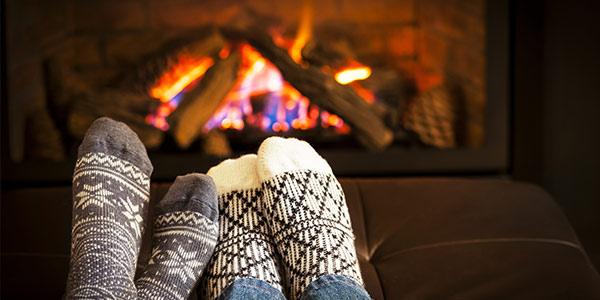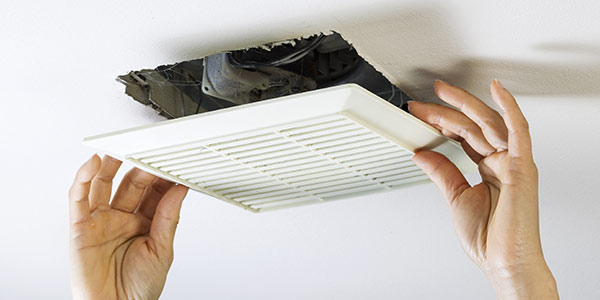These resources are from an archived version of our website. Want to see what we’ve been up to lately? Check out our new website.
Improve your indoor air quality this winter
It may seem counter-intuitive, but better energy conservation efforts in residential construction have resulted in worsening indoor air quality in new homes. That’s because, in high-performance home construction, a tighter building envelope will keep the heat (or air conditioning) in – along with the environmental pollutants. More efficient furnaces and HVAC systems are still located in basements or other enclosed spaces. Stale air is continuously recycled throughout the home. In the winter, this effect is particularly aggravated. Your utility bill stays lower, but your indoor toxin exposure goes up.

Wintertime indoor pollutants
When the weather gets cold, some of our “cozy” routines add to the mix of potential indoor air pollutants. Wintertime increases exposure to indoor toxins from combustible sources like wood-burning fireplaces. Plus, closed windows result in a build-up of VOCs (volatile organic compounds) associated with things we use every day, like air fresheners, beauty products, and household cleaners. Standard building materials, including insulation, carpet, and cabinetry can also off-gas VOCs.
Allergic symptoms can be triggered by a build-up of pet dander and dust mites. And, overly moist air, trapped inside, is the cause of mold growth – a major health hazard.
Indoor air pollutants to watch out for:
- CO2 from gas stoves and fireplaces
- Off-gassing from oil, kerosene or candles
- Off-gassing from building materials
- VOCs in cleaning products, beauty products and laundry products
- Off-gassing from house-hold items like dry cleaned drapery or upholstery
- Pet dander and dust
- Moist air from kitchens and bathrooms
Tips for improving indoor air quality
According to the EPA, the best way to combat poor indoor air quality is source control and adequate ventilation. The first step is to find ways to keep your home ventilated, even when it’s chilly outside. Additionally, here are some common-sense tips to reducing the buildup of pollutants in the first place.

Reduce indoor humidity
Combine poor ventilation with an increase in indoor air temperatures and moisture, and you’re compounding your exposure to airborne toxins.
Make sure your kitchen and bathrooms are venting properly, and open some windows when you can. Houses with a high-humidity problem should consider a dehumidifier to keep moisture in check. The EPA recommends indoor humidity in the 30 to 60 percent range.
Reduce your exposure to VOCs
Keep your exposure to respiratory irritants as low as possible with natural cleaning and beauty products. For example, laundry detergents and dryer sheets have been found to be particularly toxic. A 2011 study published in the international journal, Air Quality, Atmosphere & Health found more than 25 “volatile” air pollutants – including the carcinogens acetaldehyde and benzene in laundry products.
Keep it clean
Simple things like keeping a tidy home can make a big difference to your indoor air quality. When stuck indoors during the colder months, an uptick in dusting, vacuuming and mopping will keep pet dander and dust mites down.
Eliminate second-hand smoke
It should go without saying that smoking inside is a major allergy and asthma trigger. But second-hand smoke also comes from fireplaces, incense and candles. If you can’t outright replace your wood burning stove with a clean-burning natural gas one, you can reduce exposure to smoke by making sure your fireplace is venting properly – and scheduling regular chimney cleanings.
In the case of candles, some wax and wick types can release dangerous carcinogenic gas. Soot from burning paraffin (and other chemicals paraffin is commonly mixed with) has been shown to release the same level of pollution as the exhaust of a diesel engine. Even until 2003, commercial candle wicks contained lead. Scented and colored candles can contain synthetic oils and dyes which release microscopic particles found to cause cancer and other health problems when inhaled. If you can’t stand to give up the ambiance of candles, especially during the holidays, the Lung Institute recommends natural beeswax candles with cotton wicks.
Use quality HVAC filters
As the air is circulated throughout your home, filters in your furnace reduce polluting particles by catching them in a flat or pleated filter media. As a filter fills with particulates it becomes less and less effective. Starting the cool weather season with a clean filter, and changing it regularly, will help to reduce particulates in the air.
According to the EPA, “Most air filters have a good efficiency rating for removing larger particles when they remain airborne. These particles include dust, pollen, some molds, animal dander, and those that contain dust mite and cockroach body parts and droppings.” High Efficiency Particulate Air, or HEPA, filters do a better job at removing particles then standard filters, but not all HVAC systems have the ability to accommodate a true HEPA filter.
The American Society of Heating, Refrigerating and Air-Conditioning Engineers (ASHRAE) HVAC filter standards are based on what the industry refers to as ‘MERV’ – or “Minimum Efficiency Reporting Value” – which ranks a filter’s ability to protect your long-term respiratory health. A HEPA filter with a higher MERV rating will have a higher average resistance to airflow, giving it the ability to capture smaller particulates.
At Clarum, we use MERV 13 filters (one of the highest standards) in our custom home designs, guaranteeing superior air quality in our modern homes.

Heat Recovery System guarantee healthy air in our modern homes
Despite recommending better ventilation in homes, the EPA acknowledges most residential forced air-heating systems and air-conditioning systems do not bring fresh outdoor air into the house while exhausting indoor air with pollutant build-up.
Clarum has adopted passive home design as a fundamental approach to indoor air quality. We combine this approach with energy-efficient heat recovery ventilators (HRV) to bring fresh air into our modern homes. With an HRV system, all the air in the home is exchanged nine times a day with fresh air – guaranteeing superior air quality.
Passive, sustainably built homes seek to minimize source pollutants in the construction phase in addition to establishing whole-home systems which effectively diminish a build-up of indoor air pollutants over the long-term – not just the winter months.
Want to learn more about best practices in sustainable building? Check out our High-Performance Home Building Guide. Want to talk to Clarum about using these practices to build your modern dream home? Give us a call at 650.322.7069.








